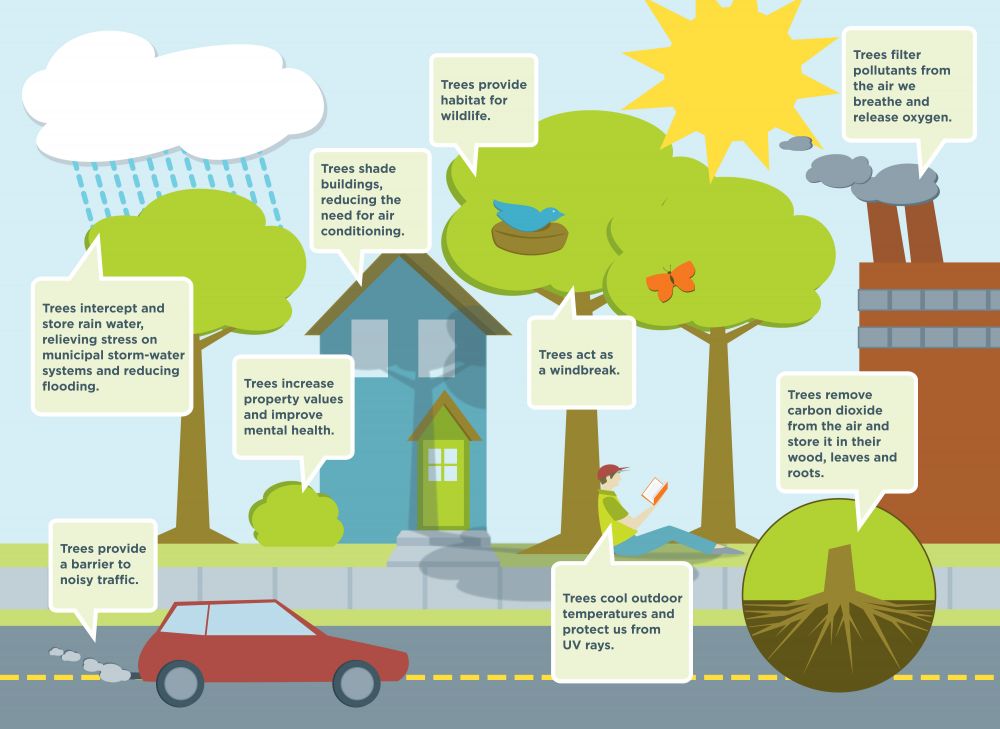Benefits of the Urban Forest
- Improves air quality by trapping dust, pollen and pollution that cause breathing problems
- Absorbs carbon dioxide and other gases, helping to fight climate change, and in return provides us with oxygen
- Cools our neighbourhoods by providing shade and releasing moisture through leaves, lowering air temperatures
- Reduces household energy use for cooling from 10 - 50%, saving money and electricity
- Intercepts rainfall, helping reduce stormwater runoff and flooding, while improving water quality
- Provides vital habitat for birds, pollinators and other wildlife
- Buffers noise by acting as a natural sound barrier
- Boosts property values
- Improves mental and physical health by encouraging time outdoors, reducing stress and supporting active lifestyles
- Builds climate resilience by protecting against heat waives, wind and extreme weather
- Strengthens community well-being, providing green spaces for connection, recreation and learning
Why choose native species?
Native trees, shrubs and perennials help protect the natural biodiversity of our urban forest.
"Native species" are plants that grew naturally in southern Ontario prior to European settlement. They’ve adapted over thousands of years to our local climate, soil and wildlife, making them a sustainable choice for our yards and communities.
As we work to support native ecosystems, we also have a responsibility and an opportunity to support reconciliation. Many Indigenous Nations have deep, ongoing relationships with the native plants of this region. Recognizing and respecting these connections is an important part of building a more just and sustainable urban forest. We are committed to learning from Indigenous knowledge systems, building respectful relationships and supporting efforts that honour Indigenous rights, voices and expertise.
In the past, cities often planted non-native species that grew quickly and could handle tough urban conditions. However, some of these species, like Norway maple (Acer platanoides), spread aggressively and began to crowd out native plants in our ravines and green spaces.
By choosing native species, we help support a healthier, more biodiverse and more resilient urban forest. Native plants tend to thrive in local conditions once established with minimal care or chemical additives. They also provide the necessary food and shelter for birds, pollinators and other urban wildlife!
Every native plant we add to our urban environment helps the natural systems that support life right here in our own neighbourhoods!
Creating an Equitable Urban Forest!
What is Tree Equity?
Tree equity means making sure all communities, regardless of race or income, have access to the many benefits trees provide. It goes beyond simply planting more trees. True equity considers:
- Distributional equity: Where trees are located
- Procedural equity: Who’s included in decisions
- Recognitional equity: Understanding and meeting different community needs
Achieving tree equity doesn’t mean every neighbourhood has the same number of trees. It means every neighbourhood has the right trees, in the right places, based on the needs and priorities of the people who live there.
Why It Matters
Trees are critical urban infrastructure. They clean our air, cool our streets, boost our well-being and help communities adapt to climate change.
However, these benefits are not shared equally. In many cities, wealthier and predominantly white neighbourhoods have more trees and green spaces. Meanwhile, communities with more low-income residents and BIPOC residents tend to have fewer trees and less canopy cover. Often this is due to a legacy of systemic discrimination.
Tree equity helps right these wrongs by ensuring that all communities can enjoy the environmental, health and economic benefits of a greener city.
How LEAF Is Taking Action
At LEAF, we believe that achieving tree equity requires meaningful, long-term investment and collaboration. We are proud to lead and support initiatives that put community at the heart of the urban forest:
Through our Toronto Community Housing Planting & Stewardship Initiative, we work with tenants and staff to plant native trees and shrubs on TCHC properties. This initiative empowers tenants to shape greener spaces and care for the trees they help plant.
Both our Young Urban Forest Leaders and Young Ravine Leaders programs support youth who identify as belonging to underrepresented groups (including women, non-binary folks, Indigenous peoples, newcomers, 2SLGBTQ+ persons and racialized individuals). Participants build skills, connect with mentors and explore green careers, helping to build a more diverse and inclusive urban forestry sector.
We’re continuing to grow our efforts to improve canopy cover in underserved areas, engage communities in stewardship and advocate for equitable policies that shape a just urban forest for everyone.
Learn more about Tree Equity


